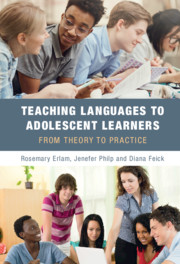Book contents
- Teaching Languages to Adolescent Learners
- Teaching Languages to Adolescent Learners
- Copyright page
- Contents
- Figures
- Tables
- Preface
- Chapter One The Adolescent Language Learner: Setting the Scene
- Chapter Two Fostering an Inclusive Language Classroom
- Chapter Three Input: Creating a Language-Rich Learning Environment
- Chapter Four Opportunities for Language Output
- Chapter Five Encouraging a Focus on Language Form
- Chapter Six A Place for Practice in the Language Classroom
- Chapter Seven Digital Media in the Language Classroom
- Chapter Eight Conclusion
- Appendix Jessica’s snake game
- References
- Index
- References
References
Published online by Cambridge University Press: 17 September 2021
- Teaching Languages to Adolescent Learners
- Teaching Languages to Adolescent Learners
- Copyright page
- Contents
- Figures
- Tables
- Preface
- Chapter One The Adolescent Language Learner: Setting the Scene
- Chapter Two Fostering an Inclusive Language Classroom
- Chapter Three Input: Creating a Language-Rich Learning Environment
- Chapter Four Opportunities for Language Output
- Chapter Five Encouraging a Focus on Language Form
- Chapter Six A Place for Practice in the Language Classroom
- Chapter Seven Digital Media in the Language Classroom
- Chapter Eight Conclusion
- Appendix Jessica’s snake game
- References
- Index
- References
Summary
Information
- Type
- Chapter
- Information
- Teaching Languages to Adolescent LearnersFrom Theory to Practice, pp. 169 - 184Publisher: Cambridge University PressPrint publication year: 2021
- Creative Commons
- This content is Open Access and distributed under the terms of the Creative Commons Attribution licence CC-BY-NC-ND 4.0 https://creativecommons.org/cclicenses/
